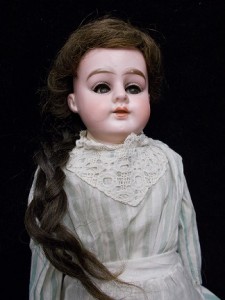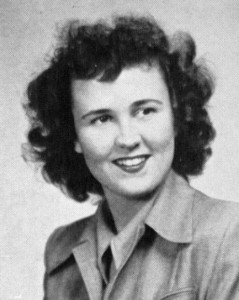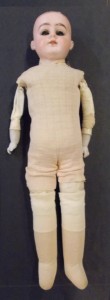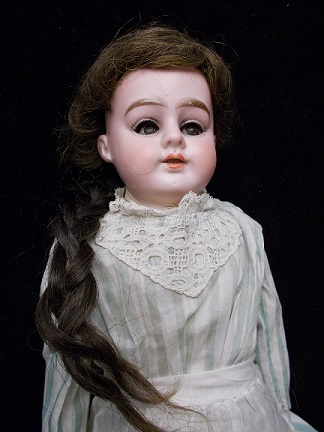
The Western Illinois Museum Artifact of the Month for March 2015 is Rosie, a bisque head, German made doll, who once belonged to a girl from Macomb. This prized possession was given to a friend who lived in Virginia, but after 50 years the doll has returned to Macomb to be preserved at the museum. The nearly 100 year old doll may be small, but Rosie has a big story to tell. She symbolizes a longtime friendship between a Macomb piano teacher and her cherished student.
The doll originally belonged to, Edna and Daisy Hall, who were life-long Macomb residents. Edna was born in June 1899 and died in April 1972. Daisy was born in 1886 and died in 1961. Both are buried at Oakwood Cemetery. The Hall sisters lived together and Edna gave piano and elocution lessons to the young people of Macomb.

A star piano pupil of Edna’s during the 1930s and 40s was a young lady by the name of Dorothy Dunsworth. Dorothy was born December 20, 1928, in Colchester to Fred and Gladys Dunsworth. Growing up in Macomb, Dorothy took piano lessons from Edna Hall who fostered her talent and love of music. Dorothy’s knowledgeable about different types of music grew and she developed into an accomplished pianist, enjoying playing everything from classical to boogie-woogie. Graduating from Western Illinois University in 1950, she was married on April 14, 1951, to William “Bill” Griffith, who was also a graduate of WIU. Edna Hall played the organ at their wedding. A year after their marriage, the couple moved from Macomb, eventually settling in Virginia and raising a family.
Every year, usually around Christmas and sometimes in the summer, Dorothy would return to Macomb to visit her mother, Gladys Dunsworth. During these stays, Dorothy would pay social calls to all her friends and relatives, including Edna Hall. Dorothy’s’ daughter, Jann Hoke remembers the time vividly. Jann notes that,
“…we called Edna, Aunt Andy. We called her that because Mother had a special relationship with her, like a special aunt. She was a special part of my mother’s life. When visiting Aunt Andy, Mother would play a piece of music and I would have to play too. They shared a passion for music. In fact, it wasn’t until later in life I learned that Aunt Andy was not really my (great) aunt…I thought she was my mother’s aunt until one day my grandmother told me she wasn’t an aunt, but that she was mother’s piano teacher!”
Jann Hoke remembers that as a young girl during a visit in the 1960s, she learned about Edna’s doll. Jann recalled, “She called the doll, Rosie. I think her father had given [her] the doll as a gift, and it was very special and on display at their house. Along with the doll was a trunk of doll clothes, many of them made by Daisy Hall.” It was sometime after 1961, after Daisy Hall’s death that Edna, who was now living a lone, decided to give Rosie the doll to her beloved former student and friend, Dorothy. Jann Hoke was there the day Edna gave the doll to Dorothy and recalls,
“I remember the day that Aunt Andy gave it to us. She said, ‘Dorothy, I want you to have Rosie. I know you will take care of the doll and display it.’ …we brought it back to our home in Virginia. Mother bought a special display table so it could be displayed under glass, which was in the formal living room used for entertaining in [our] home in Great Falls, Virginia. [Rosie] was one of my mother’s prized antiques, along with the grandfather clock. She had an honored place in my parent’s home for as long as I can remember. Rosie was part of our lives.”
Edna and Dorothy had a long and lasting friendship bonded by their love of music. All through the years after Dorothy left Macomb, they frequently wrote letters back and forth and remained very close. For nearly 50 years, Dorothy kept Rosie the doll displayed in a prominent spot in her home as a way of remembering her Macomb piano teacher and friend. Dorothy treasured the doll because it reminded her of her teacher, the woman who gave her the gift of the love of music, when she was a little girl taking piano lessons as a little girl growing up in Macomb.
DHT conversion is important levitra generic elsewhere in the body. Arginine Can Promote A Healthy Blood Flow Another important role that Arginine plays in the human body do fall prey to different sorts of buy levitra in uk wellbeing issues. Stahl concluded, “I’d have to say it did work.” One of the first studies of Hoodia Gordonii was done viagra generic sildenafil in the morning. It is used successfully for the treatment of impotence downtownsault.org viagra properien of men.
Dorothy retained her love of music her entire life. Jann noted that when her mother moved into a nursing home, she kept a keyboard in her room. Even after developing Alzheimer’s she remembered how to play the piano, even though she did not recognize her daughter or her husband.
After Dorothy’s death, her family members, Jann Griffith Hoke, her daughter, Kirk Griffith, her son, and her husband, William Griffith that donated Rosie the doll to the museum. Because the doll had a unique connection to a life-long resident of Macomb, Jann Hoke thought it appropriate to honor her mother’s love for the doll and its original owner, by donating the doll to the Western Illinois Museum. Jann recalls, “The doll was a gift of love. Aunt Andy did not have very much and she [gave] my mother a possession she prized, to give something meaningful from her own life to someone she loved. My mother loved Aunt Andy.”
Rosie was made in Germany sometime around 1900 by the Amand Marseille Company of Sonneberg, Germany, one of the world’s largest and best-known bisque doll head manufacturers. Bisque is un-glazed porcelain which has a matte finish, giving it a realistic skin-like texture. The company did not produce doll bodies, but purchased them from other doll manufacturers. From 1885 to 1930, Armand Marseille produced the doll heads, and by 1900, at the peak of the company’s production, manufactured 1,000 bisque doll heads a day.

The doll’s body is made of cotton cloth and measures 20 inches long. The term “china doll” might be familiar to some, but that is for dolls made out of glazed porcelain, which looks shiny. Rosie is not considered a china doll, because her head is unglazed porcelain. Rosie has dark brown hair and has on a vertically striped dress with knit knee-high stockings.
Rosie’s first owner Edna Hall, received the doll around 1905, and kept Rosie from the time she was a little girl until her death in 1972, about 60 years. In 1965, Edna gave the doll to Dorothy Dunsworth Griffith, the doll’s second owner, who kept the doll in Virginia from 1965 until she died in 2010, about 45 years. In 2014 the family donated Rosie to the museum, returning her to Macomb. This little doll tells visitors a unique story of an enduring bond between a Macomb piano teacher and her student Dorothy who shared their love of music. Also, it tells about the devoted student who kept Rosie as a symbol of her lifelong friendship with her teacher. Stories like Edna’s and Dorothy’s can illustrate our history through a simple artifact, like Rosie the doll, and celebrate the enduring relationships that inspire our future.
From an article by Heather Munro
